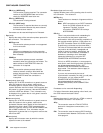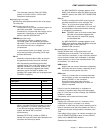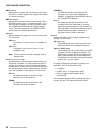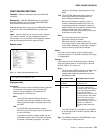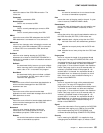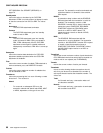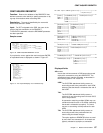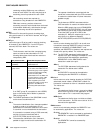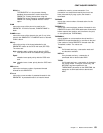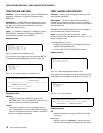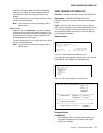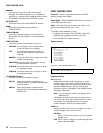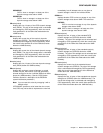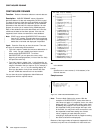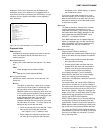
CEMT INQUIRE DB2ENTRY
containing multiple UOWs may use a different
thread for each UOW. The result may be that an
accounting record is produced for each UOW.
NOne
No accounting records are required for
transactions using threads from this DB2ENTRY.
DB2 does, however, produce at least one
accounting record for each thread when the thread
is terminated. Additionally, authorization changes
cause accounting records to be produced.
AUTHId
returns an ID to be used for security checking when
using pool threads. If an AUTHId is returned, AUTHType
is not applicable.
AUTHType
returns the type of ID to be used for security checking
for threads on this DB2ENTRY. If an AUTHType is
returned, AUTHid is blank. The values are:
Group
The 8-character userid and the connected group
name are used as the authorization ID. The
following table shows how these two values are
interpreted by DB2.
If no RACF group ID is available for this USERID,
then an 8-character field of blanks is passed to
DB2 as the group ID.
Sign The SIGNID parameter of the DB2CONN is used
as the resource authorization ID.
TErm
The terminal identification (four characters padded
to eight) is used as an authorization ID. An
authorization ID cannot be obtained in this manner
if a terminal is not connected with the transaction.
If a transaction is started (using a CICS command)
and has no terminal associated with it,
AUTHTYPE(TERM) should not be used.
TX The transaction identification (four characters
padded to eight) is used as the authorization ID.
OPid
The operator identification associated with the
userid that is associated with the CICS transaction
is used as the authorization ID (three characters
padded to eight).
USerid
The 8-character USERID associated with the
CICS transaction is used as the authorization ID.
When the DB2 sample sign-on exit DSN3@SGN
is used with AUTHTYPE(USERID), the exit sends
the USERID to DB2 as the primary authorization
ID and the RACF group ID to DB2 as the
secondary ID. When the sample sign-on exit is
used, there is no difference between
AUTHTYPE(USERID) and AUTHTYPE(GROUP).
DIsabledact
returns a value showing what CICS is to do with new
transactions accessing DB2ENTRY when it has been
disabled or is disabling. If DISABLEDACT is not
specified, and DB2ENTRY is disabled, new requests are
routed to the pool by default. The values are:
Pool The CICS DB2 attachment facility routes the
request to the pool. Message DFHDB2072 is sent
to the transient data destination specified by
MSGQUEUEn on the DB2CONN for each
transaction routed to the pool.
ABend
The CICS DB2 attachment facility abends the
transaction.The abend code is AD26.
SQlcode
An SQLCODE is returned to the application
indicating that the DB2ENTRY is disabled.
DRollback
returns returns a value showing whether the CICS DB2
attachment should initiate a SYNCPOINT rollback if a
transaction is selected as victim of a deadlock resolution.
The values are:
Rollback
The attachment facility issues a sync point rollback
before returning control to the application. An SQL
return code of -911 is returned to the program.
NORollback
The attachment facility does not initiate a rollback
for this transaction. An SQL return code of -913 is
returned to the application.
ENAablestatus
returns a cvda indicating whether the DB2ENTRY can
be accessed by applications. The values are:
Enabled
The DB2ENTRY can be accessed by applications.
DB2ENTRY is installed in an ENABLED state.
Disabled
The DB2ENTRY cannot be accessed by
applications.
IDs passed to DB2 How DB2 interprets values
CICS sign-on user ID
(USERID)
Represents the primary DB2
authorization ID.
RACF connected
group name
If the RACF list of group options
is not active, then DB2 uses the
connected group name supplied
by the CICS attachment facility
as the secondary DB2
authorization ID. If the RACF list
of group options is active, DB2
ignores the connected group
name supplied by the CICS
attachment facility, but the value
appears in the DB2 list of
secondary DB2 authorization
IDs.
68 CICS Supplied Transactions



